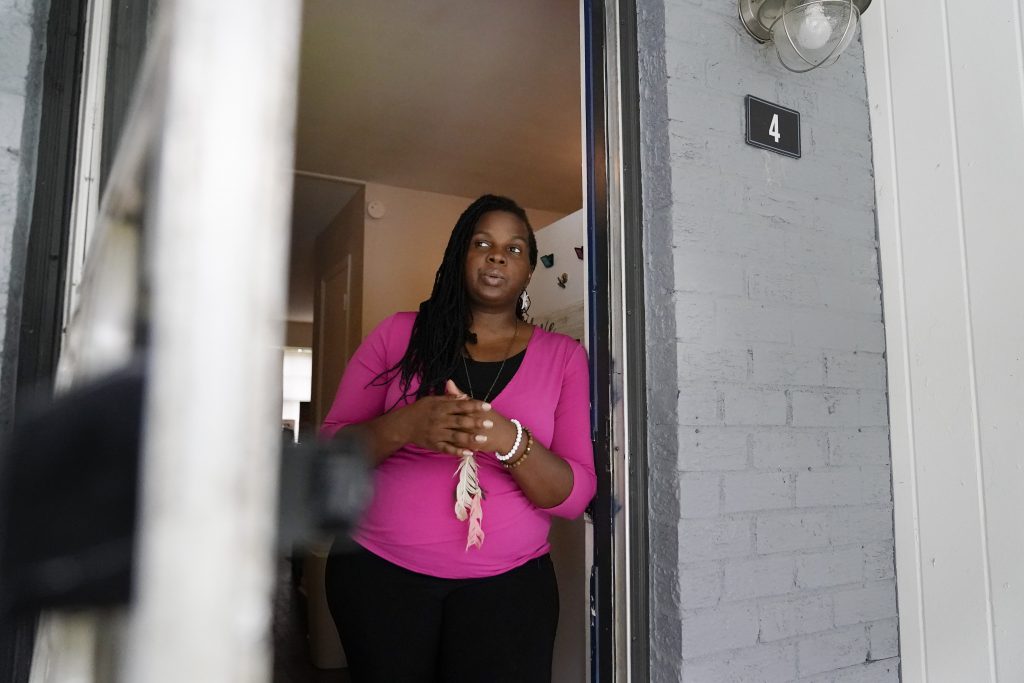This story was published in partnership with The Associated Press.
Introduction
Subscribe on Google | Apple Podcasts | Spotify | Amazon
Before the pandemic hit, Jacqueline Bartley, a mother of two girls and a boy, had a comfortable life. Then the 41-year-old lost her job at American Airlines, quickly spent her savings and found herself months behind on the $1,350-a-month home she rented. Until then, she had never missed a rent payment.
Bartley, of Durham, North Carolina, turned to the state’s rental assistance program and was relieved in January to be awarded $8,100. But she says her landlord refused the money after she rejected his request to amend her two-year lease to a shorter period. The program required landlords to honor leases, among other conditions, to get the money.
She turned to a second program launched this month by the state and again was approved. She recently learned the landlord had accepted nearly $20,000 for back rent and several months of prospective rent. He has agreed to dismiss the eviction lawsuit he’d filed.
The news means she won’t be forced from her home after the federal eviction moratorium ends July 31. But the waiting and uncertainty meant months of stress.
“It’s been crazy especially when you have children in school,” Bartley said. “It’s pretty much been going by a whim. OK, am I going to have somewhere to go?”
Millions have found themselves in situations similar to Bartley’s, facing possible eviction despite bold promises by governors to help renters after Congress passed the sweeping CARES Act in March 2020.
Nationwide, state leaders set aside at least $2.6 billion from the CARES Act’s Coronavirus Relief Fund to prop up struggling renters, but a year later, more than $425 million of that — or 16% — hadn’t made it into the pockets of tenants or their landlords, according to an investigation by the Center for Public Integrity and The Associated Press.
“It’s mind-boggling,” said Anne Kat Alexander, a project manager with Princeton University’s Eviction Lab. “I knew there were problems but that’s a huge amount of money not to be disbursed in a timely manner.”
The federal government had an eviction moratorium in place for the majority of 2020 and the first half of 2021, but landlords across the country have found creative ways around it. People in communities of color have been far more likely to receive eviction notices during the pandemic than people in white neighborhoods, according to an analysis by Public Integrity of eviction data in 2020.
Hurdles in the early days
Like many state leaders, North Carolina’s Democratic Gov. Roy Cooper pledged to roll out an ambitious program last year offering tens of millions of dollars in federal aid that would help cover unpaid rent.
But it took months to get up and running and stopped accepting applications just weeks after it finally opened in October due to overwhelming demand. The 20 nonprofits designated to distribute the money often lacked the capacity to get it out quickly.
Then, faced with the Republican-controlled Legislature’s takeover of CARES Act spending in January, the state had less money to award applicants. It eventually spent $133 million of a promised $167 million — far short of what some housing advocates say is needed.
“We knew the money would not be enough. There were too many people who needed rental assistance,” said Pamela Atwood, director of housing policy at the North Carolina Housing Coalition. “There was a lot of poor execution in rolling out that first program and it caused a lot of inefficiency.”
After the legislature took control of CARES spending in January, scuttling plans by the governor to put an additional $50 million of federal spending into rental assistance, the state was forced to rush to find money to pay tenants whose rental assistance applications had been approved. They turned to a new stream of federal spending, known as Emergency Rental Assistance. But that left the state $34 million short of its goal.
“We pivoted and we fulfilled the mission,” said Laura Hogshead, chief operating officer of the North Carolina Office of Recovery and Resiliency. “We went to the new funding to fill the coffers. We honored every award that we made last fall.”
Still, advocates criticized the program for closing so quickly and leaving many struggling renters without a source of assistance.
“It was not nearly enough,” said Peter Gilbert, director of the Durham eviction diversion program for Legal Aid of North Carolina, noting that the funding in his city was probably a tenth of what was needed.
“It could have made a huge difference,” he said. “They would have been able to stay in their homes. Many of these families are back to work and able to pay their rent going forward. What they are not able to do is pay off a balance of six to nine months from last year without help, so it’s going to be a major disruption, not only to the lives of these individual families but it is really going to change the face of our cities across North Carolina.”
Tens of billions of dollars more in rental assistance have been delivered to states from the federal government in 2021, but those have been slow to be disbursed, too.
With the first round of funds in 2020, bureaucracy was not the only problem. Politics also played a role, with a handful of states, many led by Republicans and with a history of weak tenant protections, offering little to no assistance.
Then there was the often onerous application process and an end-of-the-year federal deadline for spending the money, extended so late that some states had already pulled funding to use on other expenses. Some landlords refused to participate over restrictions that meant they could not evict a tenant who fell behind again after the assistance. Tenants sometimes short-changed themselves by filing incomplete applications.
Delayed reaction to the need for rental assistance
Faced with a housing crisis that could have been worse than the foreclosure flood of the 2007-2009 Great Recession, Congress sent billions of dollars to states and some local governments with the 2020 CARES Act. But it didn’t mandate that any money be spent on rental assistance, leaving it to states to create their own programs and set the rules.
According to the National Low Income Housing Coalition’s database of rent relief programs in 2020, Georgia, West Virginia and Tennessee, all run by Republican governors, chose not to set up statewide rent relief programs in 2020, despite having higher than average historic eviction rates. Alabama, whose historic eviction rate was not as high, also didn’t administer a statewide relief program in 2020. South Carolina allocated less than $14 per renter-occupied household that year.
Georgia’s Department of Community Affairs tried to set up a rental assistance program with funds from the U.S. Department of Housing and Urban Development in the fall of 2020, but when it became clear that a separate, larger tranche of money would be coming from the U.S. Department of the Treasury in 2021, the program stalled, said Susan Reif, housing unit director for Georgia Legal Services Program and director of the Eviction Prevention Project.
“It’s the equivalent of a fire hose feeding into many different garden hoses,” Reif said. “An agency that handles a $50,000 grant doesn’t have the sophistication to handle a million-dollar grant. It just wasn’t a system that could handle the amount of money that was suddenly thrown into it.”
“It just wasn’t a system that could handle the amount of money that was suddenly thrown into it.”
Susan Reif, housing unit director for Georgia Legal Services Program
Kaley Volkmann, a contract spokeswoman for Georgia’s Department of Community Affairs declined to answer questions about whether the head of the department asked Republican Gov. Brian Kemp to use money from the CARES Act for a rental assistance program in 2020. Volkmann also declined to discuss the plans to use HUD funding for rent relief.
The state did set up a statewide rental assistance program in March — a full year after the pandemic began. Just $7 million had been distributed as of June 15, out of $552 million allocated.
Rental assistance keeps people housed.
Willicia Carswell of Macon, Georgia, nearly lost her home in 2020. The mother of three answered the door on her oldest daughter’s birthday to find her landlord demanding rent.
She handed him the last $200 she had.
“He took it, even though I told him it was my baby’s birthday,” said Carswell, who was out of work at the time. “My best friend was sitting there and I started crying.”
Carswell said the United Way of Central Georgia paid her rent and utilities and helped her pay for toys for her children for Christmas. She eventually found a job as a medical assistant and caught up on her rent and utility bills.
‘It could have saved lives’
Officials in West Virginia have not explained why they declined to set up a statewide rental assistance program in 2020. Housing advocates said they are not surprised, in part because the state has one of the country’s highest rates of home ownership and low numbers of renters per capita. Tenants are often college students and low-income residents.
“Renters are disconnected from each other, and there has not been any kind of group or community organizing,” said Katheryn Marcum, a staff attorney for Legal Aid of West Virginia. “Because these folks are the most vulnerable of our residents, I would say that they probably don’t have reliable access to the internet. They probably don’t have reliable access to resources and probably are really spread out.”
But one city in West Virginia, Parkersburg, did offer its renters some assistance. It earmarked $229,739 in CARES Act funding. So far, it has allocated one-quarter of that amount to 50 residents facing eviction or utility cutoffs.
We can’t do this work without your support.
“Obviously, this program addressed a critical need, even more so in the summer and fall of 2020” Mayor Tom Joyce said. “These resources … hopefully helped alleviate some of their problems and prevented them going into greater debt. This also allowed landlords to get their rents paid and avoided their own financial perils related to the pandemic.”
Other states moved quickly in the early days of the pandemic, creating massive programs to keep families in their homes — the safest place to shelter during the coronavirus pandemic. By the summer of 2020, state and local government officials launched about 530 rental assistance programs, setting aside at least $4.3 billion from various sources.
Several states were praised for programs that ran well. Illinois, Indiana, Oregon and Washington state were among more than a dozen that reported distributing every dollar of the rental assistance set aside from the Coronavirus Relief Fund by March 31.
The Center for Public Integrity surveyed about 70 state and local agencies that the National Low Income Housing Coalition identified as having set aside Coronavirus Relief Fund money for rent help in 2020. About $1 out of every $6 of that $2.6 billion wound up getting spent on other COVID-19-related expenses, such as protective equipment, police officers’ salaries and small-business loans.
Some states also spent millions of dollars setting up their programs, including North Carolina, which allocated around $20 million on administrative costs, and Hawaii, which spent $8 million. In the case of Hawaii, much of that went to help nonprofits scale up and rent space. The state also spent money on mortgage assistance and a software system in an effort to prevent fraud.
“It could have saved lives,” said Diane Yentel, executive director of the National Low Income Housing Coalition. “There has been some pretty compelling, clear research that has shown in places where eviction moratoriums were allowed to expire and tenants were evicted for nonpayment of rent, it led to increases in deaths from COVID-19.”
Yentel said last year’s funding challenges led Congress to earmark nearly $47 billion specifically for emergency rental assistance in December and March.
“The previous funds, the vast majority of them, were very flexible and had a broad set of allowable uses,” of which eviction prevention was just one, said Yentel, whose group has been tracking rental assistance programs.
“Some states and cities carved out some of those funds for eviction prevention and to create emergency rental assistance programs,” she said. “But many didn’t, or many didn’t set aside enough.”
Rental assistance ‘set up to fail’
Among the biggest challenges was states’ failure to spend what they had allocated.
The Pennsylvania Housing Finance Agency received $150 million to help renters but returned about $96 million to the state treasury, which plugged holes in the state’s public safety budget.
Florida spent 60 percent and Montana less than 20 percent before each sent back the rest to their treasuries. New York reported allocating just under half.
New York’s 2020 rent-relief program “was set up to fail” because of the stringent requirements that tenants had to comply with, said Ellen Davidson, a staff attorney at The Legal Aid Society in New York. “It was a program that really punished people. There was a real intention to make sure people didn’t do better in being hurt by COVID, so if they were struggling before, they should be struggling after.”
Tenants had to prove they were “rent-burdened” before the pandemic to qualify for rent relief in 2020, though eventually that stipulation was removed.
New York State Homes and Community Renewal “is acutely aware that this pandemic has put more pressure on New Yorkers who were already housing insecure, and we worked intensely for months to ensure rent-burdened households received the assistance for which they qualified,” said Charni Sochet, spokeswoman for the department, which oversaw the assistance program. “By November, the rent relief program quickly delivered funding to renters most in need.”

Christina Drzal, an attorney with Legal Aid of Southeastern PA, said the Pennsylvania Housing Finance Agency sent so much money back to the state treasury because the cap on how much money each household could receive — $750 per month for a maximum of six months — was too low and the paperwork burdens were too high.
“The consensus was generally that it was kind of a failure,” Drzal said. “We are constantly in court and there are people being evicted all the time.”
Bryce Maretzki, director of policy and planning with the state’s housing finance agency, said many tenants had trouble proving they were at least 30 days delinquent on their rent. And in some parts of the state, rents are two to three times the amount his agency was allowed to provide.
“We would love to have been able to get more dollars into the hands of more landlords on behalf of tenants,” Maretzki said. “The counties did everything they could up until the last moment of the program to get dollars out.”
Hawaii spent around $71 million of the $100 million initially promised, though an analysis by the Hawaii Appleseed Center for Law and Economic Justice found the state spent the most per capita nationwide. Still, the Legislature set a late December deadline for the spending, which meant the remaining $29 million had to be redirected to the state’s unemployment insurance trust fund.
“Rather than setting a particular date as our Legislature did, it would have been better to base the ending of the program on the CARES Act spending deadline with whatever extensions were enacted, because ultimately the deadline was extended,” said Gavin Thornton, the center’s executive director. “If that had been done, the program would have continued, and landlords and tenants would have been able to continue to access those funds, which were certainly needed.”
Denise Iseri-Matsubara, the executive director of the Hawaii Housing Finance and Development Corporation, which created the rental and mortgage assistance program, acknowledged there were challenges in part because the program had to be “stood up in record time.”
“This really was the first program of this scale for Hawaii,” she said. “So there were a lot of course corrections that had to be made. … I think everyone did their best to help the community.”
Smaller cities and counties were affected, too. In Marion County, Florida, none of the $1 million set aside for renters from the Coronavirus Relief Fund ever made it to people who needed it because the United Way of Marion County, which administered the funds, didn’t have enough workers to process applications, said Scot Quintel, the organization’s president. The United Way was able to distribute rent assistance from another source, but the Coronavirus Relief Fund money went back to the city for other COVID-19-related expenses.
“It’s just horrifying how ill-prepared some states were,” said Alexander, of the Eviction Lab. “Some places made it work and some places didn’t, which demonstrates that the places that didn’t probably could have.”
In Athens, Georgia, Dylyn Price said she got about $5,800 in rental assistance but that may not prevent her from losing her home. After her pay and hours at a fast food restaurant were cut, eviction notices started arriving in early 2020. They haven’t let up.

Price received rental assistance from the Ark, a nonprofit administering funds from the CARES Act on behalf of the city of Athens, but the assistance ended earlier this year. Price’s landlord has refused to renew her lease after it expires June 30. The company cited both her inability to pay and her efforts to fix that by renting out a room on Airbnb.
She fears having to live, once again, in a homeless shelter with her 14-year-old son.
“It’s a very nauseating and uncomfortable situation to be in,” Price said.
Sarah Kleiner is a senior reporter at the Center for Public Integrity. She can be reached at skleiner@publicintegrity.org. Follow her on Twitter at @bysarahkleiner.
Taylor Johnston is a data fellow at the Center for Public Integrity.
Kimberly Cataudella contributed to this report. She is a data fellow at the Center for Public Integrity. She can be reached at kcataudella@publicintegrity.org. Follow her on Twitter at @kcataudella.
Read more in Health
Coronavirus and Inequality
The eviction ban is over. Here’s why people are worried.
Rental relief funds were often slow to trickle out. For many, help never arrived.
Coronavirus and Inequality
Another blow to working people during the pandemic: states snatching back tax refunds
During the pandemic, states are continuing to deduct money from tax refunds to collect delinquent debts, burdening those who have suffered the most from the COVID-19 recession.







Join the conversation
Show Comments